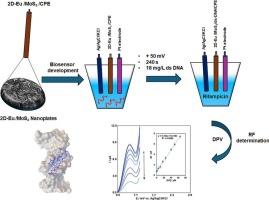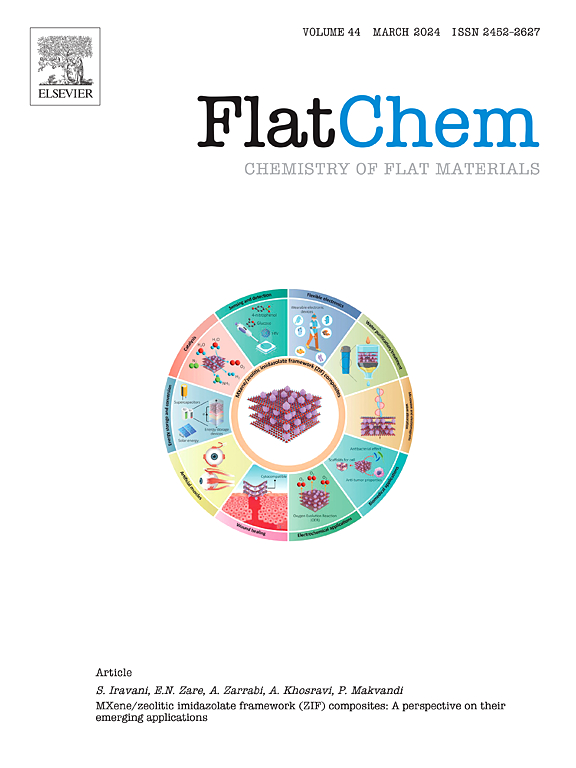基于二维铕/MoS 2纳米复合材料的高效DNA生物传感器用于检测利福平
IF 6.2
3区 材料科学
Q2 CHEMISTRY, PHYSICAL
引用次数: 0
摘要
本研究利用高效电化学DNA生物传感器建立了灵敏的利福平检测平台。该传感平台是通过用二维铕(III) -二硫化钼纳米复合材料(2D-Eu(III)/MoS 2)和固定双链DNA修饰碳糊电极(CPE)构建的。这项工作旨在利用MoS 2纳米复合材料和铕(III)的协同特性来提高药物- dna相互作用分析的电化学性能。利用扫描电子显微镜(SEM)、x射线衍射(XRD)和能量色散x射线(EDX)技术对纳米材料进行了表征。差分脉冲伏安法(DPV)用于监测鸟嘌呤响应,由于RF与DNA的优先结合,鸟嘌呤响应显著降低。该传感器灵敏度为0.103 μA/μM,检出限为38.0 nM,线性检测范围为0.09 ~ 65.0 μM。成功的应用证明了实际样品,包括药物配方,血清和尿液。在实际样品分析中,该传感器的回收率为96 ~ 104%,相对标准偏差(RSD)小于4.0%,具有较高的准确性和可靠性。该研究的创新之处在于设计了一种基于2D-Eu(III)/MoS 2的纳米平台,该平台可以增强DNA负载能力并放大电化学活性,与之前报道的传感器相比,为射频提供了更好的传感系统。本文章由计算机程序翻译,如有差异,请以英文原文为准。

A highly efficient DNA biosensor based on 2D-europium/MoS₂ nanocomposites for rifampicin detection
In this study, a sensitive rifampicin (RF) detection platform was established using a highly efficient electrochemical DNA biosensor. The sensing platform was constructed through the modification of a carbon paste electrode (CPE) with two-dimensional europium(III)–molybdenum disulfide nanocompsites (2D-Eu(III)/MoS₂) and immobilized double-stranded DNA. This work was designed to leverage the synergistic properties of MoS₂ nanocompsites and europium(III) to achieve enhanced electrochemical performance for drug–DNA interaction analysis. The nanomaterial was characterized using scanning electron microscopy (SEM), X-ray diffraction (XRD), and energy-dispersive X-ray (EDX) techniques. Differential pulse voltammetry (DPV) was employed to monitor the guanine response, which decreased significantly due to the preferential binding of RF to DNA. The biosensor exhibited excellent sensitivity of 0.103 μA/μM, a limit of detection (LOD) of 38.0 nM, and a linear detection range of 0.09–65.0 μM. Successful application was demonstrated in real samples, including pharmaceutical formulations, serum, and urine. In real sample analysis, the biosensor showed recoveries of 96–104 % with relative standard deviation (RSD) below 4.0 %, demonstrating high accuracy and reliability for practical applications. The innovative aspect of this study was in the design of a 2D-Eu(III)/MoS₂-based nanoplatform that enhances DNA loading capacity and amplifies electrochemical activity, providing a superior sensing system for RF compared to previously reported sensors.
求助全文
通过发布文献求助,成功后即可免费获取论文全文。
去求助
来源期刊

FlatChem
Multiple-
CiteScore
8.40
自引率
6.50%
发文量
104
审稿时长
26 days
期刊介绍:
FlatChem - Chemistry of Flat Materials, a new voice in the community, publishes original and significant, cutting-edge research related to the chemistry of graphene and related 2D & layered materials. The overall aim of the journal is to combine the chemistry and applications of these materials, where the submission of communications, full papers, and concepts should contain chemistry in a materials context, which can be both experimental and/or theoretical. In addition to original research articles, FlatChem also offers reviews, minireviews, highlights and perspectives on the future of this research area with the scientific leaders in fields related to Flat Materials. Topics of interest include, but are not limited to, the following: -Design, synthesis, applications and investigation of graphene, graphene related materials and other 2D & layered materials (for example Silicene, Germanene, Phosphorene, MXenes, Boron nitride, Transition metal dichalcogenides) -Characterization of these materials using all forms of spectroscopy and microscopy techniques -Chemical modification or functionalization and dispersion of these materials, as well as interactions with other materials -Exploring the surface chemistry of these materials for applications in: Sensors or detectors in electrochemical/Lab on a Chip devices, Composite materials, Membranes, Environment technology, Catalysis for energy storage and conversion (for example fuel cells, supercapacitors, batteries, hydrogen storage), Biomedical technology (drug delivery, biosensing, bioimaging)
 求助内容:
求助内容: 应助结果提醒方式:
应助结果提醒方式:


